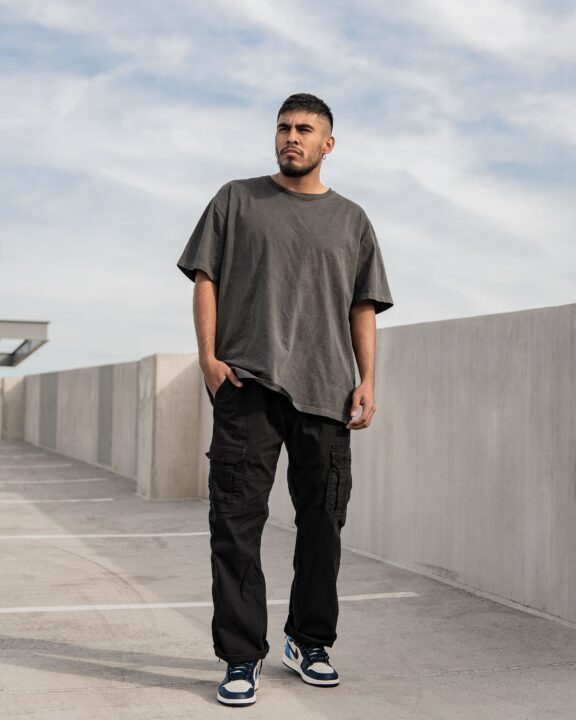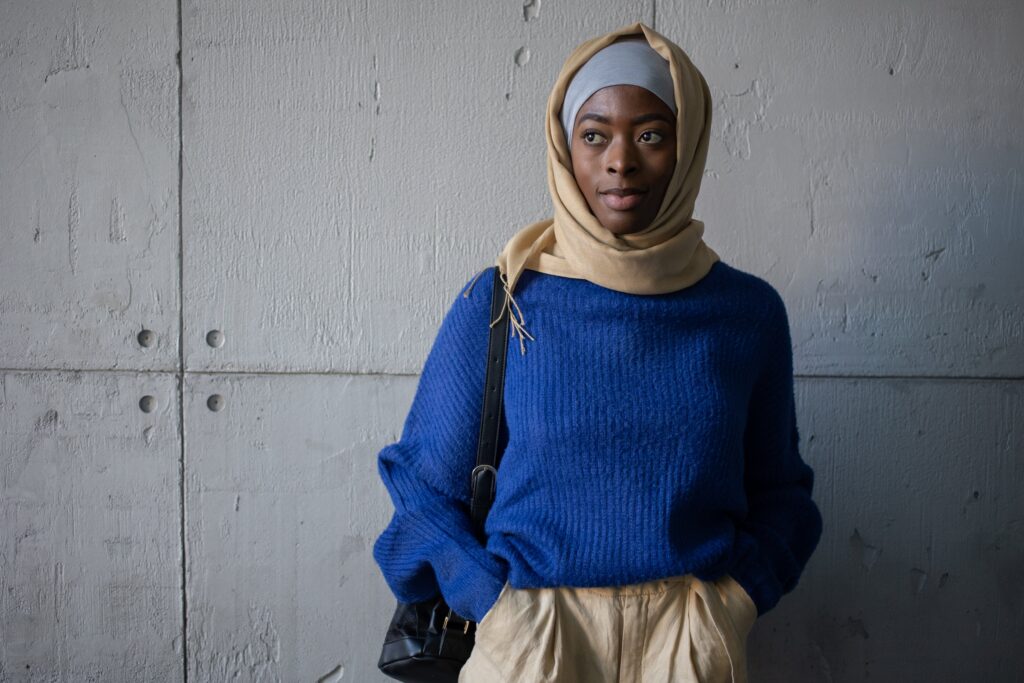Body language is a type of nonverbal communication that includes the vast number of ways we communicate with our bodies and facial expressions. It often speaks louder than our words.
Keeping your hands in your pockets is one of those body language gestures that can have multiple, seemingly contradictory meanings.
In cases such as the ‘hands in pockets’ gesture, you need to look at the context of the situation and accompanying gestures to reach a sound conclusion.
5 Common Interpretations for Hand in the Pocket
1. Comfort and Casualness
-

pexels-david-gari-17333852.jpg
Sometimes, people put their hands in their pockets simply because it’s comfortable. When we’re feeling relaxed and at ease, we may unconsciously adopt a more casual posture. In this case, hands in pockets can signify that the individual is feeling good and doesn’t have any pressing concerns.
So, next time you’re chatting with someone who’s rocking the hands-in-pockets look, take note of their general body language. Are they feeling relaxed and confident? If yes, take it as a sign that they’re likely enjoying the conversation.
2. Hiding Nervousness
This is the old ‘hide your sweaty palms’ trick. It’s a classic! If you haven’t heard of it, here’s how it works.
People may impulsively put their hands in their pockets when they’re feeling nervous or anxious. It could be a way to hide those telltale signs of nervousness, like fidgeting or trembling hands.
So, if you notice someone’s hands disappearing into their pockets during a high-stakes situation, it might be a signal that they’re feeling the pressure. This is especially true if it’s accompanied by other signs of nervousness, like sweating on the forehead and the palms.
3. Reserved or Defensive
Sometimes, hands in pockets can indicate that a person is feeling reserved or defensive. This posture can create a barrier between the individual and the people they’re interacting with, showing that they’re not quite ready to open up.
If you notice someone constantly keeping their hands in their pockets during a conversation, it could be a sign that they’re hesitant to share or connect on a deeper level. You can make the person feel more relaxed by giving them space and asking less personal questions.
4. Confidence and Dominance
-

tony eight media, pexels, 10346849.jpg
Here’s an interesting twist! Hands in pockets can also be a sign of confidence or dominance. How?
When we place our thumbs in our pockets and let our fingers hang out, it’s often a gesture of assertiveness. This position can make us appear larger and more in control, showcasing our self-assurance.
5. Cold Weather or Habit
-

monstera production, pexels, 6282018.jpg
Let’s not forget the most practical reason for putting our hands in our pockets: it’s cold! Sometimes, the simplest explanation is the right one.
People may just be trying to keep their hands warm, and there’s no hidden meaning behind it. Similarly, some individuals may have developed a habit of keeping their hands in their pockets and it doesn’t necessarily reflect their emotions or intentions.
Frequently Asked Questions
-
Is it rude to put your hands in your pocket?
The question of rudeness is often subjective and varies from one culture to another. In some situations, placing your hands in your pockets might be considered impolite or disrespectful.
For example, during a formal event or when speaking with a superior, it’s generally best to avoid this gesture. It can come across as too casual and even convey a lack of interest or engagement.
However, in more relaxed settings or when interacting with friends, placing your hands in your pockets might not raise any eyebrows.
-
In what country is it rude to keep your hands in your pockets?
Cultural norms surrounding body language can vary significantly from one country to another.
In certain countries, such as Japan and South Korea, keeping your hands in your pockets can be considered impolite, particularly in formal settings or when interacting with someone of a higher social status.
This gesture might be interpreted as a sign of disrespect, laziness, or disinterest. So, when traveling or interacting with people from different cultural backgrounds, learn to be aware of these nuances and adapt your behavior accordingly.
A little research and cultural sensitivity can go a long way in ensuring that you make a positive impression.
-
What does it mean when a guy puts his hands in his pockets while talking to you?
When a guy places his hands in his pockets while talking to you, it could signify a range of emotions or intentions.
He may be feeling comfortable and casual, demonstrating a sense of ease during the conversation. On the other hand, he might be trying to hide nervousness, like fidgeting or sweaty palms.
Alternatively, this gesture could indicate that he’s feeling reserved or defensive, creating a barrier between you and him.
-
Why do guys put their hands in their pockets in pictures?
Guys might choose to put their hands in their pockets in pictures for several reasons. One possibility is that they’re trying to project a casual, cool or confident image.
This pose can come across as laid-back and self-assured, making it a popular choice for photographs. Plus, placing hands in pockets can help someone feel more at ease, particularly if they’re unsure of what to do with their hands during a photo.
In other cases, it could simply be a matter of habit or personal preference. The reasons behind this choice often vary significantly from person to person.
Contextual Analysis
Professional Settings
Imagine you’re in a business meeting, and one of the presenters has their hands tucked in their pockets. It can be a tricky read, right? While it might come off as relaxed, there’s a fine line where it can tip into unprofessional territory
But there’s always a risk – does it make him look confident or too casual? I witnessed this firsthand while attending a seminar for directors. Instantly, you could discern the discomfort of one director compared to the other, simply by observing how they used their hands or where they placed them.
Job Interviews
Picture Sarah, sitting across the table during a job interview, hands in their pockets. It could show she’s at ease but could it also hint at a lack of preparation? It’s like walking a tightrope – being seen as comfortable versus being perceived as unprepared. It’s all about reading the room! In general, we don’t recommend you put your hands in your pockets.
Social Scenarios
-
First Dates
Ah, the jitters of first dates! Now, if Joshua keeps his hands in his pockets, is he just laid-back or not that into the conversation? It’s a classic dilemma. Hands-in pockets can be a cool, casual vibe but they can also send mixed signals. It’s all about the balance, isn’t it?
-
Parties and Gatherings
At parties, there’s always that one person, hands in pockets, exuding a chill vibe. Take Jude, for example – he’s friendly but has this habit. Some see it as being open and approachable, while others might have read it as standoffish. Social cues, they’re a puzzle, aren’t they?
Educational Environments
-
Classroom Settings
Remember that one professor who’d lecture with hands in pockets? It made them seem easygoing but some students felt it was a bit too casual for the classroom. It’s interesting how body language can stir up such mixed feelings!
-
Public Speaking
When Ruth took the stage with her hands tucked away, it was a curveball. Some felt it made her relatable, while others thought it took away from the authority of her speech. In most cases, it depends on the other body gestures of the speaker.
Cultural Contexts
-
Eastern Cultures
In places like Japan or China, hands in pockets can be a bit of a cultural faux pas. It’s seen as casual, sometimes too casual.
-
Western Cultures
Out West, it’s a different ball game. Hands-in pockets are as common as apple pie. It’s relaxed, and easy, but can sometimes be read as aloof. It’s all about the context and setting, a dance between casual and too casual.
Situational Contexts
-
Celebratory Events
The joy of celebrations! But even here, hands in pockets is a dance of perceptions. Is it a laid-back attendee enjoying the moment or someone detached from the festivities? It’s a melody of silent cues and unspoken narratives! It can be hard to judge just on one piece of body language alone.
Outcome Of Negative Body Language
Poor body language; hands in pockets, poor posture, or fidgeting can undermine what we’re trying to communicate with our words.
Negative or ineffective body language can make us come across as nervous, aggressive, or impatient, and it can make those around us feel incredibly uncomfortable. Having good communication skills is paramount in the 21st century.
Final Words
Hands-in-pocket body language can mean a variety of things, ranging from comfort and casualness to nervousness, defensiveness, or even confidence.
The key to understanding what it means is to consider the context and other body language cues. This will help you accurately interpret the message being conveyed. And remember, sometimes people just have chilly hands! Sometimes it’s just the weather.






